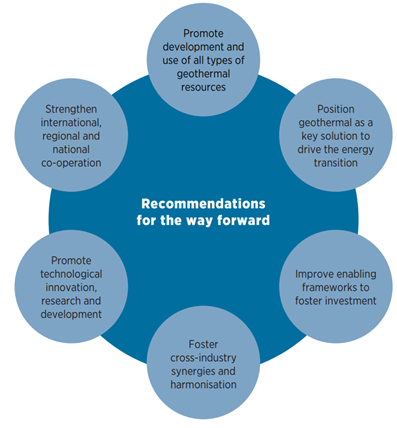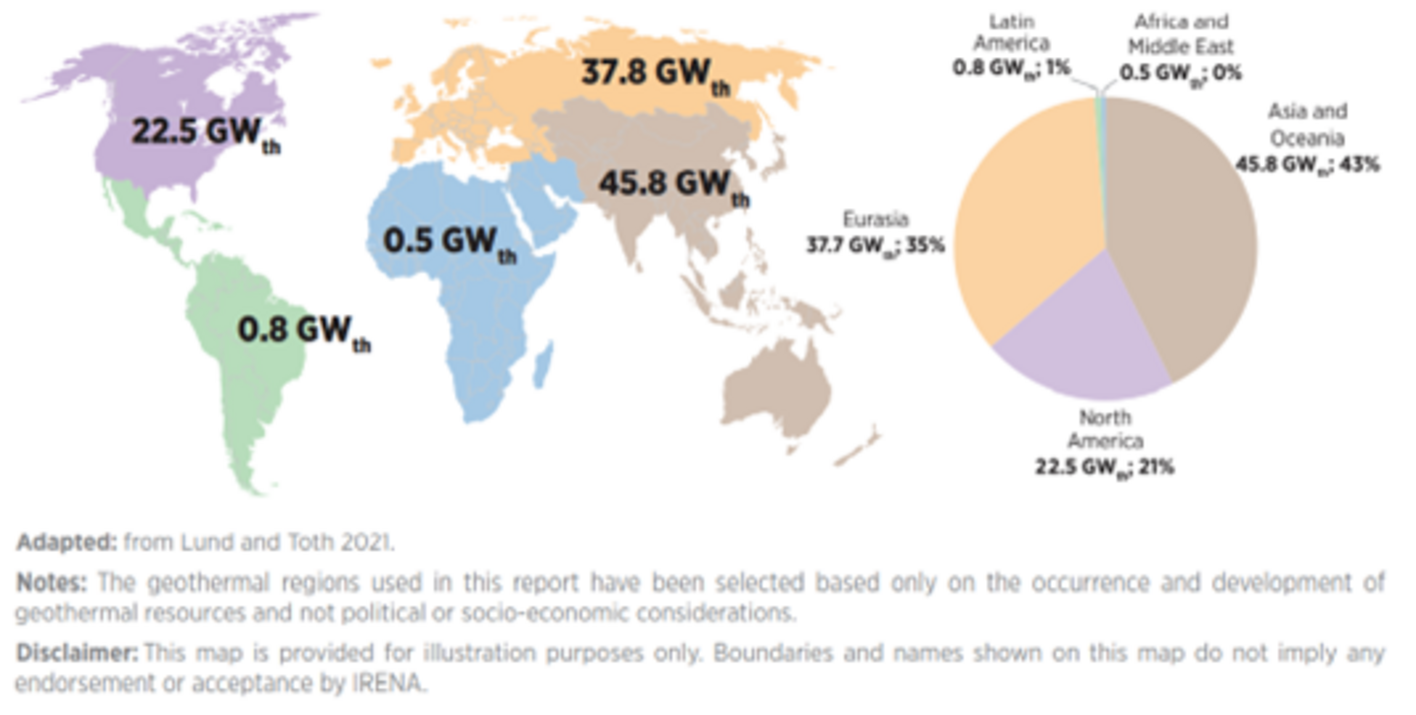Published on 28 February 2023
Geothermal energy’s untapped potential
Geothermal energy can and should play a greater role in meeting global energy needs, both for electricity as well as heating and cooling, according to a recent report by the International Renewable Energy Agency (IRENA) and the International Geothermal Association (IGA). ‘Geothermal resources are widely available in areas with volcanic activity and in sedimentary basins. As geothermal energy is a weather-independent, continuous, reliable and renewable energy source, it offers the opportunity to accelerate the transition to a carbon-neutral and climate-friendly energy system,’ according to the report.
The growth of geothermal energy use worldwide is driven by multiple factors. First, energy demand is increasing as a result of economic growth. To counteract climate change and move towards a green economy, there is a global effort to transition to renewable energy sources, especially in light of geopolitical developments and energy security. In addition, the demand for sustainable heat is also increasing, leading to a growing trend in utilising geothermal resources for heating and cooling applications where it is technically and economically feasible. Finally, with the recent accelerated deployment of intermittent power from wind and solar photovoltaic (solar PV), geothermal energy can be used to generate electricity to stabilise electricity grids.
Growth in heating and cooling
The use of geothermal energy for electricity and heating cooling accounts for a mere 0.5 % of the world wide installed renewables-based capacity. Its growth rate has also been modest compared with other renewable energy sources. For electricity generation, the use of geothermal energy has grown at a rate of around 3.5 % annually, reaching a total installed capacity (globally) of almost 16 gigawatts electric (GWe) in 2021.
On the other hand, geothermal deployment for heating and cooling grew at an average rate of around 9 % annually between 2015 and 2020 to reach 107 gigawatts thermal (GWth) in 2020 (see figure below).
Competitive energy source
In countries with deregulated electricity markets, cost plays an important role in determining which renewable energy sources are ‘most applicable and cost-effective’. Over the past decade, renewable electricity sources (mainly solar and wind power) have become very cost‑competitive. Declining technology costs have lowered their levelised cost of electricity (LCOE) by 67-88 % and 60-68 % respectively.
On the other hand, the LCOE of geothermal electricity generation has remained largely constant, falling within the range of USD 0.05-0.07 per kilowatt hour between 2010 and 2021. This, however, is within the lower band of the cost of fossil fuel-based electricity.
Ample room for growth
Although geothermal energy has been in commercial use for more than a century, it has not evolved into a mature market yet in most countries. Its use has mainly been limited to hydrothermal resources found in particular geological locations and ground source heat pumps. Because only a tiny fraction of the available hydrothermal resources (i.e. high-temperature resources) has been tapped, there is ample room for market growth in many countries. This could be driven by utilising low- and medium temperature resources or even by using existing technologies. Expansion could be challenged, however, by various financial, regulatory, technical, logistic, environmental and social barriers.
Mitigating risks and financing structures
Harnessing geothermal resources involves various risks – such as subsurface resource uncertainties – and requires a relatively large up-front investment for drilling. Financing and risk mitigation have been the subject of many research projects. Several regional and national risk mitigation schemes have been implemented around the world. At the same time, regulatory frameworks for geothermal projects are being reviewed and updated in many countries where a lack of clear policies and regulations exacerbate various barriers.
Cost reduction
Zooming in on cost and associated risks for geothermal energy projects, these are particularly relevant in the early project stages where the uncertainty of the resource potential and the up-front investment required for exploration drilling are high. However, there is potential to lower the resource development costs, hence the LCOE, particularly during the drilling phase. Project developers are implementing industry best practices during the drilling phase to achieve cost-reduction. These practices include predicting and circumventing potential drilling problems in advance to reduce the duration of drilling; using advanced subsurface modelling techniques to target permeable structures and drill highly productive wells; and managing the geothermal reservoir properly to slow the decline in well production and thus minimise the need for makeup wells.
Cross-industry synergies
The IRENA/IGA report also identifies integrated cross-industry approaches as very important for boosting geothermal energy. Cross-industry projects allow the geothermal industry to exploit synergies with other industries, including other renewables, the oil and gas industry, green hydrogen production, mineral recovery (such as lithium or other valuable minerals from geothermal brines), energy storage in abandoned mines, as well as carbon capture storage and utilisation in geothermal formations.
Recommendations
On a more general level, the report recommends several options for lowering barriers to geothermal electricity, heat generation and locally cooling and accelerating the development and utilisation of geothermal resources (see figure below).

Long-lasting source
To summarise, geothermal energy holds a unique place in the renewable energy ecosystem for being able to continuously generate both electricity and heat, independent of weather conditions. As an electricity source it offers continuous, reliable generation with high plant efficiency, low greenhouse gas emissions and a small ecological footprint. As a heat source it is scalable, has low operating costs, increases efficiency by using heat directly, reduces electricity consumption, and can provide a long-lasting source of sustainable heat. Finally, geothermal energy also has ample room for technological innovation. This could be in the exploratory stage or it could relate to developing advanced systems to increase geothermal efficiency, lower costs, or gain access to previously inaccessible areas. In short, geothermal energy has significant potential – high time to tap into it.
Game changer
The International Renewable Energy Agency (IRENA) is an intergovernmental organisation that supports countries in their transition to a sustainable energy future and serves as the principal platform for international cooperation as well as a centre of excellence and a repository of policy, technology, resources and financial knowledge on renewable energy.
The International Geothermal Association (IGA) is the leading global platform for geothermal energy, serving as a hub for networking opportunities aimed at promoting and supporting global geothermal development. Together with industry partners, the IGA sets standards, develops the technology agenda and supports entrepreneurs engaged in clean technology. With its four pillars – visibility, sustainability, partnerships and authority – the IGA is committed to pushing geothermal energy as a gamechanger for achieving Sustainable Development Goal 7: ensure access to affordable, reliable, sustainable and modern energy for all.
Together with JRG Energy Consultants, Witteveen+Bos supported IRENA in developing this assessment of the global geothermal market and technology. This not only included an extensive literature study but also comprised several interviews and consultations with regional geothermal experts from around the world. It also involved writing a comprehensive and peer-reviewed report on global and regional insights and developments.
Share this page
Contact

